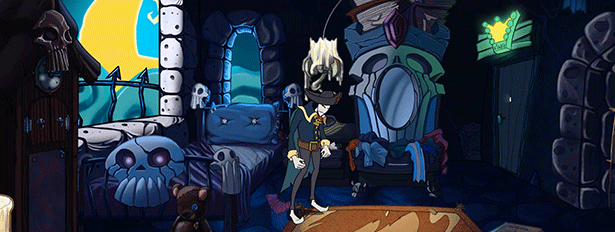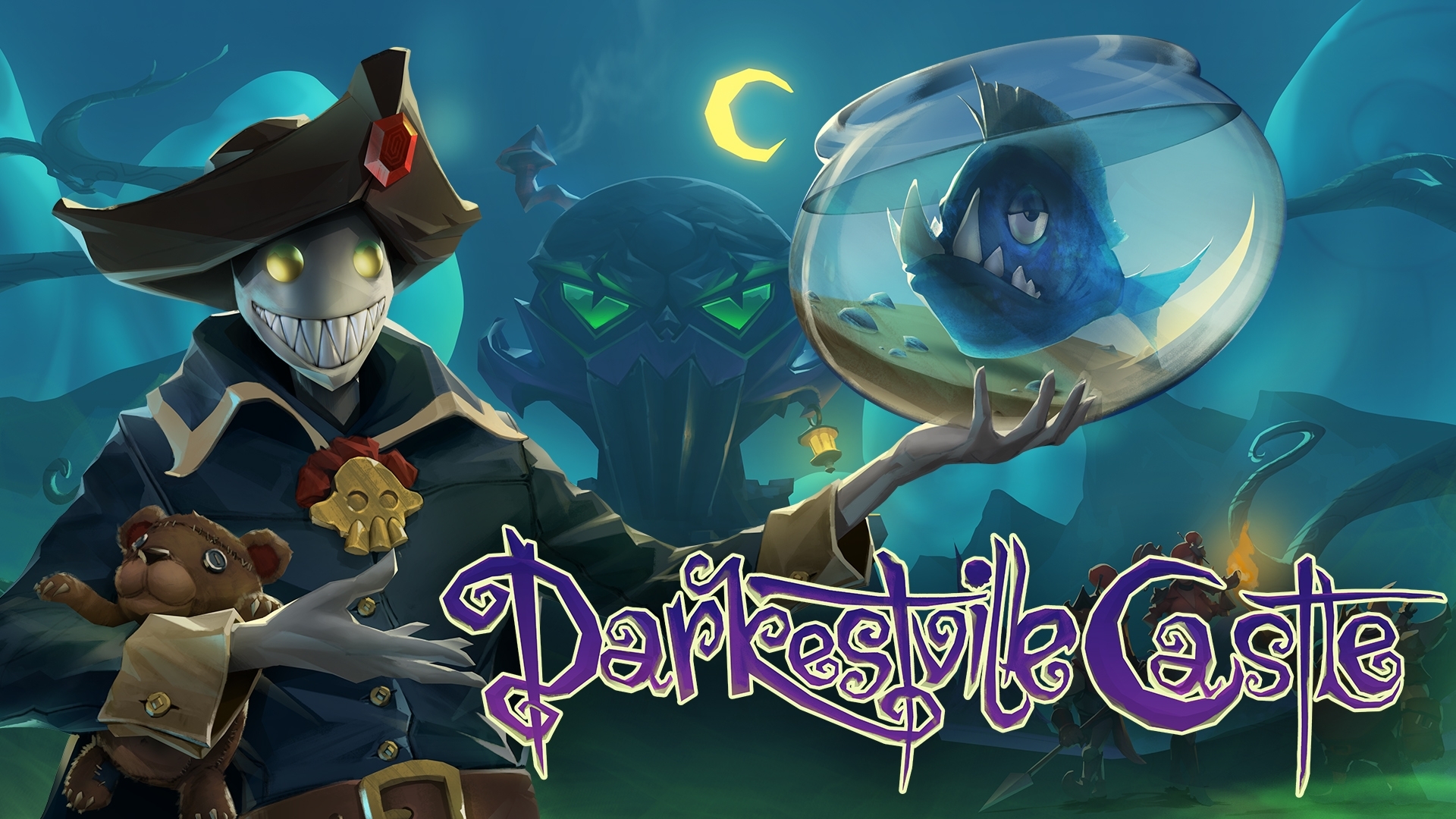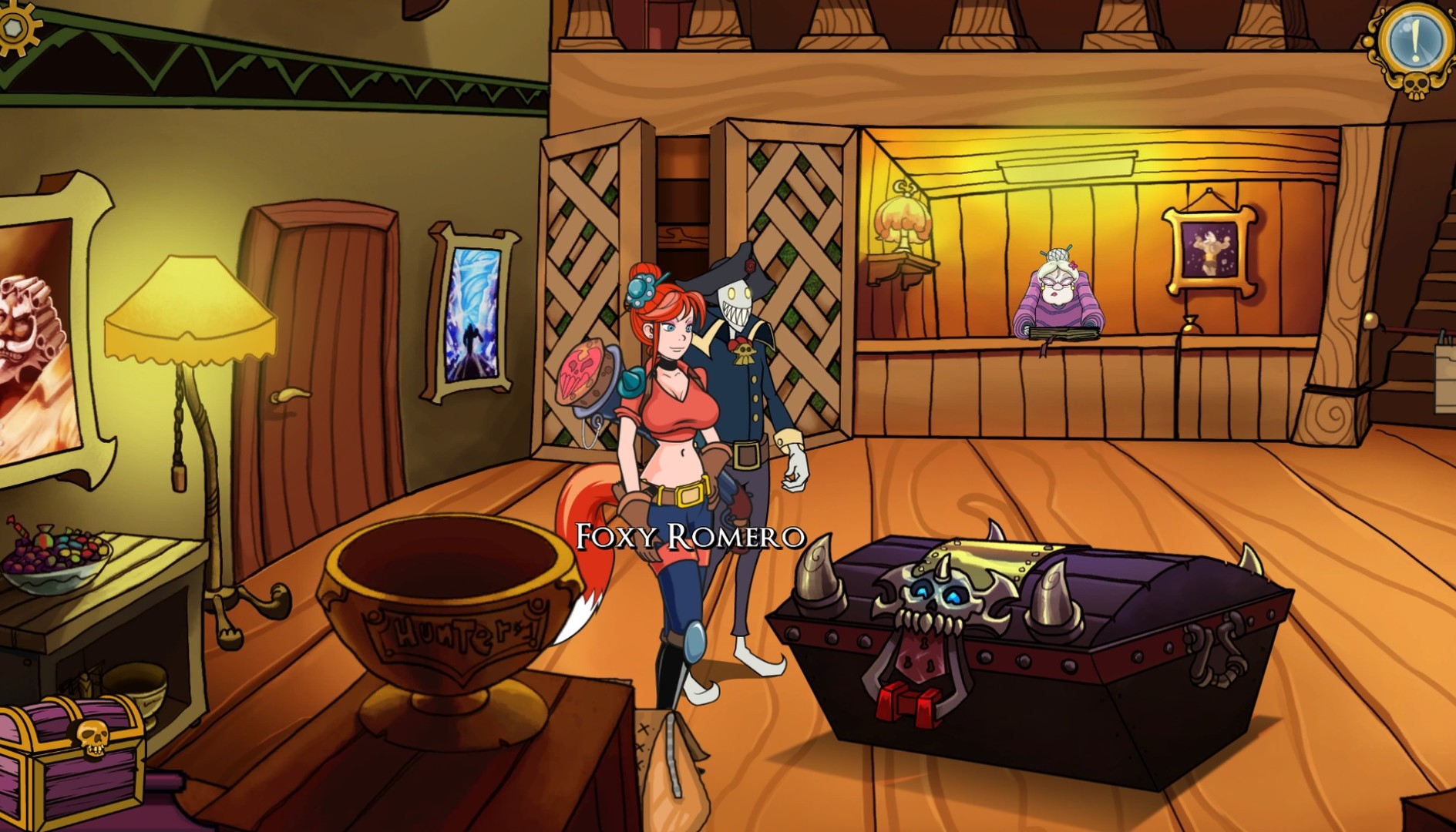
Like any decent demon Cid spends his nights performing all kind of evil deeds to the peaceful people of Darkestville. Little does he know that his old arch enemy is about to change his life forever.
Live the adventure of Cid, the demon of Darkestville, a laid-back being of pure darkness that will see his evil routine life disrupted by The Romero brothers, a group of demon hunters hired by Dan Teapot, Cid’s arch enemy. Follow CId through an epic quest full of danger, intrigue, and ridiculous premises.
The game pays tribute to late 90’s point-and-click adventure games, featuring fascinating fairy-tale story and trendy visuals in Tim Burton’s style. It delivers more than 7 hours of truly enjoyable gameplay to both old and new generations. Dive into the unforgettable good old-fashioned atmosphere of classic adventure games and meet dozens of funny characters living in this amazing hand-painted world of Darkestville Castle.

- Point-and-click adventure classics in the same vein as Monkey Island and Day of the Tentacle
- Lots of Tim Burton-esque gallows humor
- Funny characters and charismatic protagonist
- Dozens of carefully designed levels
- Quirky and trendy visuals
- Numerous puzzles
- Captivating story
- More than 7 hours of exciting gameplay
- Violence, horror and death-free adventure for all ages
- This Game has been awarded with an INDIE PRIZE as the BEST GAME NARRATIVE


In 1990, LucasArts, formerly known as Lucasfilm Games, released an amazing story about Guybrush Threepwood, a brave young man who dreamed of becoming a pirate. His pixelated adventures caught the fancy of players and were followed by four more games the final part of Tales of Monkey Island was released in 2009, along with the re-release of the original. Even a simple nostalgia was enough for an ordinary point-and-click game to skyrocket in the charts, leaving first-class shooters behind.
And in fall of 2017, the developers of the Argentine studio Epic Llama ventured to release a new two-dimensional humorous exploration game Darkestville Castle, which followed the patterns of Monkey Island and it also brought the success.
So let us discover what relations these projects have and why do they enjoy unfailing popularity.
https://www.youtube.com/watch?v=hKG9ZkwPU5U
The story of one hero
Monkey Island showed us that the heart of any quest is its story, which is always tied to a protagonist. Therefore, inventing a charming playable character is already half of the success. In Darkestville Castle, this role is given to The Great and Terrible Cid, who with his charm, sense of humor and ingenuity is likely to conquer anyone. And yet he is a demon, meaning that in terms of love and affection for people he didnt go far from his senior pirate colleague who similarly, although often violated the law, evoked sincere sympathy.
Cid himself admits their similarity: a single glance at the rum is enough for him to feel like a real sea dog. Stealing socks from citizens and bantering over his neighbor Dan Teapot are only part of his daily duties. By the way, minor hooliganism without any claims for universal dominance is entirely in the spirit of Guybrush Threepwood, the protagonist of the Monkey Island series once he even blew up half an island!
That being said, the demon of Darkestville is not worse than the mighty pirate Guybrush: he easily pushes the story forward and doesnt lose heart before the tricky puzzles truly the Guybrush-type character!

Sometimes a storyteller wedges into Darkestville Castle and, similarly to the re-release of Monkey Island 2: LeChuck's Revenge, helps to face an adventure without getting out of the chair.
The protagonist is surrounded by vivid minor characters, who are most likely to talk anybody to death. There are a lot of dialogues in the game, all of them being diverse, witty and making anyone smile from ear to ear. Some of Cid's interlocutors may even deliver whole lectures: for example, the werewolf Cid met on the streets of the city fights for the equality among humans and lycanthropes, and the piggy in the mayors waiting room skillfully handles legal terms.
Each of them is a part of a fictional world: not only they enrich it, but also bring themselves closer to the players who live in these sometimes boring and tedious realities. But you can easily laugh at them as well! Something similar was present in Monkey Island, when the beach watchman recited the rights and duties of people at the beach in long and boring manner. As a result, a couple of extra lines in the script really made the characters sound more natural.

Sometimes the Darkestville characters behave as though they have visited the Monkey Island: for example, one of the demons wishes good luck with the search for a ring that will remove the curse (this was Guybrush's main task in the third Monkey Island series), you have to just listen closely to their squabbles.
In most cases, it is their talkativeness that leaves no brick at the fourth wall. The walrus from the Romero Brothers, similarly to the pixelated one-eyed drunkard, feels that all of them are characters of an already written story. Cid continues the tradition established by Guybrush and comments on each of players actions. For example, he complains that he has to dig through the garbage way too often, or hints that the player may not have outstanding intellectual abilities.
This is almost like a separate scenario technique that has grown into other projects. For example, the visual novel Stanley's Parable is fully built on the interaction of the player and the game itself: they provoke each other, and by having done something bad they both wait for a responding reaction from the other side of screen. This technique helps to build an invisible bridge between the game and the player, saving the latter from a sense of detachment in terms of what is happening on the screen it becomes much more interesting to play when the characters begin to communicate with you.

In Darkestville some characters believe that vegetables have pretty much a whole family.
The communication with the viewer is also supported with the help of Easter eggs. Most of them are addressed to the ideological mastermind of the game: for example, the port Puerto Pollo (spa. Chicken Port) in Monkey Island was replaced by Epic Llama with Praia dos frangos (por. Chicken beach);they have also added a note about coriander, the most popular spice for alcoholic beverages in the biology book, and even the name Darkestville Castle, as in the case of Monkey Island, is a reference to a specific location in the game. All of this is a disguised reminder of the beautiful classical game and a tribute to its traditions, for there also were Easter eggs and in-game manuscripts.
In addition, the developers have also added hints at modern games and films, such as Robot Chicken-RoboCop and MMORPG. Moreover, there was a reminder of the adventures of Indiana Jonesin the creation of Schafer. One cannot simply go without that, for another way to win the love of players is to give them a feeling of being part of the virtual world and its active resident.

Some characters of Darkestville Castle feel like having an annoying cursor before their eyes.
One click, two click
The town of Darkestville is filled with the mechanics of the old school series: even the cursor is borrowed from The Curse of Monkey Island. The interaction of objects is carried out by dragging each item has to be dragged through the whole screen. And this needs to be done fairly often, because the most obvious solution is not always right, and to find the answer, players have to try many combinations as all the laws of the genre presume. Though, there are no direct hints, as in the games about the Monkey island, you can only highlight all the clickable objects.
Monkey Island had many odd solutions as well: who would expect the saucepan to be an incredibly spectacular, and most importantly, a useful headwear!

Argentine developers also borrowed from LucasArts some aspects concerning the logic of the narration, levels, structure and even the design of some chapters and their openings.
Epic Llama have also come up with several non-trivial challenges for the players. In one of them player has to perform three tasks: steal three keys from the members of the Romero brothers gang, and this task will require showing a fairy wit. It is not worse at any matter than a fierce pirate swearing battle or a competition for throwing a Scottish caber, albeit on a smaller scale. Even with the simplest mechanics, a little variability will only be for the best, and even more interesting than the usual linear quests.
Boss battles are another deja vu. The whole action resembles a hunt: the furious demon chases the hero in four or five locations and can only be defeated by examining the territory and inventing something on the move, and using the right object during the short break. Such a battle is much more dynamic and even ... more dangerous! The enemy is not so easy to defeat, for they are constantly on the tail just think of the battle with LeChuck in the amusement park!

The endings for both projects are also not what they may seem.
Getting lost in the decorations priceless
It is interesting that a game with a completely different setting filled with dark humor and gloomy charm found a place in itself for the colorful scenery of a tropical islands ballad about pirates of all sorts although both worlds have their own charm. The center of the city in Darkestville may as well pretend to be the town square of the Melee island from The Secret of Monkey Island, and the bright orange domains of King Vigo to be the lava subsoil of the Monkey Island, where the bloodthirsty LeChuck kept in hostage Guybrushs beloved one. All of these are places as dangerous, as they are beautiful.
Sometimes Darkestville Castle lacks songs and rhymed humoresques, like the good old Monkey Island has. However, the motives are similar here and there.
It is important that Darkestville has its own mythology.Though being the simplest, it enlivens the game world. Demons, a crew of half-decaying zombie-like deadmen, spiritual parallel universes all of these are still almost the most favorite topics among fans, even after three decades.
In addition, the ideological successor of the Monkey Island is completely hand-drawn, scarce in special effects and otherwise resembles the two-dimensional Curse of Monkey Island, where the depth of the scene is determined by the size of the character, depending on his location on the screen.
It is peculiar that even with incredible graphics capabilities such representation of the game world,combined with a jamming musical theme still attracts the fans of old school projects. And it happens not without a reason. When in 2000 LucasArts tried to enliven the world by adding a third dimension, the game suffered a loss in realism and became plasticine. This problem was fixed only when Telltale Games started working on the next part of the game.

Escape from Monkey Island locations became less atmospheric because of 3D-graphics.
It is amazing that even now the two-dimensional quest genre can easily win more popularity than first-class shooters. The new Darkestville Castle has proved that the interest to such game format has not faded away yet. The point here is the continuity of imperishable classics: a lovable protagonist, bright companions, an exciting story and excellent humor everything that is necessary for the quest to be successful, even thirty years after Monkey Island.
Being hand-drawn, both games bear strong resemblance to our world with its oddities and laws which we are somehow accustomed to. Due to this similarity one wants to hang out with Cid for longer, think hard over the puzzles and have a good laugh together.
And on top of that to experience an indescribable feeling of deja vu in relation to classics. It is worth much.
Minimum Setup
- OS: Ubuntu 18.04 LTS
- Processor: 2.5 GHz (Single Core) or 2 GHz (Dual Core)Memory: 2 GB RAM
- Memory: 2 GB RAM
- Graphics: DirectX 9.0 compatible
- Storage: 2 GB available space
[ 6432 ]
[ 7154 ]
[ 3653 ]
[ 5363 ]













































